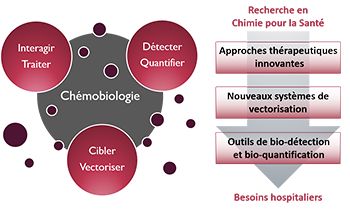- ⌂
-
Le DPM
Les Equipements
L'Environnement
Zoom sur... Le Bâtiment André Rassat
Nommé d'après une figure tutélaire de la chimie grenobloise, ce bâtiment est recouvert d’une double peau en feuille métallique qui apporte une protection thermique sur 3 côtés et crée une unité architecturale favorisant l'intégration parmi les arbres du site.
-
Thématiques
Le Thème
« Approches thérapeutiques innovantes »De nouvelles solutions thérapeutiques, de la cible biomacromolécu-laire émergente aux approches originales pour traiter les maladies
Le Thème
« Nouveaux systèmes de vectorisation »Combiner les propriétés d’inclusion de principes actifs, de franchisse-ment de barrières, d’adressage et de relar-gage en milieu vivant
Le Thème
« Outils de bio-détection et bio-quantification »Des dispositifs analytiques originaux pour la détection de cibles, de l’ion au micro-organisme en milieu complexe
Zoom sur... La Chémobiologie

-
Équipes
L'Équipe « COMET »
« COMET » développe la conception rationnelle, la synthèse et/ou l'extraction de composés à forte diversité/complexité comme nouveaux agents thérapeutiques et outils moléculaires pour la pénétration cellulaire ou la détection de biomolécules, actifs in vivo.L'Équipe « NOVA »
« NOVA » utilise des acides nucléiques fonctionnels comme éléments de reconnaissance pour des applications thérapeutiques ou diagnostiques, comme la sélection d'oligonucléotides, ou le développement de dispositifs d'analyses et de nanovecteurs.Les Services
-
Productions
Les Publications
La Vulgarisation
Les JSM
Zoom sur... La 12ème JSM (15 juin 2023)
Le DPM organise des journées scientifiques consacrées au médicament. L'objectif est de rassembler les spécialistes académiques et industriels autour d'une thématique. 2023 : Apports de la Chimie Click et de la Lumière en Chemobiologie
-
Partenariats
Les Formations
Les Consortiums
Les Financements
Zoom sur... L'environnement Grenoblois
Le DPM est un acteur central sur le bassin grenoblois en chimie, biologie et santé, lié au CHU Grenoble Alpes et à de nombreuses autres organisations : Pole de Recherche CBS, ICMG, Labex ARCANE, EUR CBH, Institut Carnot Polynat, Réseau GREEN.
Article
- Projet
- Farid OUKACINE,
- Titre
- Study of Antibacterial Activity by Capillary Electrophoresis Using Multiple UV Detection Points
-
[Full paper
 ]
] - Auteurs
- F. Oukacine, B. Romestand, D. M. Goodall, G. Massiera, L. Garrelly, H. Cottet
- Edition
- Anal. Chem. 2012, 84, 3302-3310.
- Année
- 2012
- Résumé
- A new methodology for an antibacterial assay based on capillary electrophoresis with multiple UV detection points has been proposed. The possible antibacterial activity of cationic molecules on bacteria (Gram-positive and Gram-negative) is studied by detecting the bacteria before, during, and after their meeting with the cationic antibacterial compound. For that, a UV area imaging detector having two loops and three detection windows was used with a 95 cm x 100 mu m i.d. capillary. In the antibacterial assay, the bacteria (negatively charged) and the cationic molecules were injected separately from each end of the capillary. The bacteria were mobilized by anionic ITP mode while cationic molecules migrate in the opposite direction under conditions close to CZE. The cationic molecules were injected into the capillary as a broad band (injected volume about 16% of the volume of the capillary) to prevent dilution of the sample during the electrophoretic process. Bacteriolytic activity, as well as strong interactions between the small antibacterial molecules and the bacteria, can be investigated within a few minutes. The assay was used to study the antibacterial activity of dendrigraft poly-L-lysines on Micrococcus luteus and Erwinia carotovora. Because dendrigraft poly-L-lysines are nonimmunogenic and have low toxicity, this new class of dendritic biomacromolecules is very promising for antibacterial applications.




 Annuaire
Annuaire Contact
Contact Plan d'accès
Plan d'accès ENG
ENG Login
Login


